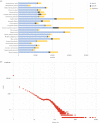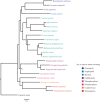MolluscDB: a genome and transcriptome database for molluscs
- PMID: 33813885
- PMCID: PMC8059625
- DOI: 10.1098/rstb.2020.0157
MolluscDB: a genome and transcriptome database for molluscs
Abstract
As sequencing becomes more accessible and affordable, the analysis of genomic and transcriptomic data has become a cornerstone of many research initiatives. Communities with a focus on particular taxa or ecosystems need solutions capable of aggregating genomic resources and serving them in a standardized and analysis-friendly manner. Taxon-focussed resources can be more flexible in addressing the needs of a research community than can universal or general databases. Here, we present MolluscDB, a genome and transcriptome database for molluscs. MolluscDB offers a rich ecosystem of tools, including an Ensembl browser, a BLAST server for homology searches and an HTTP server from which any dataset present in the database can be downloaded. To demonstrate the utility of the database and verify the quality of its data, we imported data from assembled genomes and transcriptomes of 22 species, estimated the phylogeny of Mollusca using single-copy orthologues, explored patterns of gene family size change and interrogated the data for biomineralization-associated enzymes and shell matrix proteins. MolluscDB provides an easy-to-use and openly accessible data resource for the research community. This article is part of the Theo Murphy meeting issue 'Molluscan genomics: broad insights and future directions for a neglected phylum'.
Keywords: database; genome; molluscs; protein families; shell matrix proteins; transcriptome.
Figures


References
-
- Gomes-dos-Santos A, Lopes-Lima M, Castro LFC, Froufe E. 2020. Molluscan genomics: the road so far and the way forward. Hydrobiologia 847, 1705-1726. (10.1007/s10750-019-04111-1) - DOI
Publication types
MeSH terms
Associated data
LinkOut - more resources
Full Text Sources
Other Literature Sources
Molecular Biology Databases
Research Materials

